By Dr Noeleen Smyth
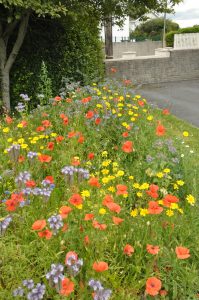
We would never tolerate the release of an exotic animal to our wider environment yet we appear happy to release packets of unregulated wildflowers.
Just as we enjoy seeing exotic animals from all over the world in a zoo and keeping domestic pets in our home environments, we would never tolerate a herd of roaming elephants, or cats and dogs wandering in packs around our housing estates. Seeing exotic wildflowers into our wider environment is as shocking to me as seeing a herd of elephants on the N7. We need to address the real elephant in the room which is the continued sale and use of inappropriate wildflower seed mixes.
All experts agree that these mixes, when sown outside gardens, are detrimental to local biodiversity. We have already seen the accidental introduction of “Black Grass” (Alopecuros myosuroides) from a wildflower seed mix, described as a “particularly pernicious weed” in the UK. We were lucky that here it was found in a Teagasc trial before it was planted into the margin of every tillage field in Ireland.
No regulations on wildflower seed mixes in Ireland
Experts in the Dublin Naturalist Field club have created an informative article on the use of wildflower seed and their potential detrimental impacts. Shockingly, there are absolutely no regulations to cover the sale and the contents of these wildflower packets here in Ireland.
There is, however, some hope, from a voluntary group called the European Native Seed Producers Association (ENSPA). This group, with members in Northern Ireland, follow a code of conduct and aim to produce quality seeds from sustainable and traceable sources to maintain genetic diversity. However, few if any members of this group produce seed in the Republic of Ireland.
In our gardens we like to grow plants from all over the world. It’s part of the joy of gardening and horticulture. This is the same as keeping domesticated cats and dogs in our home and the excitement of seeing hippos and elephants in the zoo. As interesting and enthralling as these exotic animals are, we would never ever consider letting them out to roam free. With exotic plants it’s just the same thing. If we grow exotic things we also bear the responsibility of not letting them escape to grow in our wider environment which is already at a “tipping point” with existing challenges of dramatic species and habitat losses.
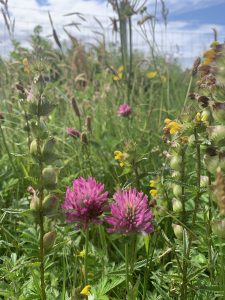
If we had a euro for every packet of unregulated wildflower seed bought to feed the bees and put the money into protecting our native wildflowers in Irish meadows, we could secure a future for Irish bees and wildflowers.
Some very shocking statistics exist for Irish biodiversity in general, with figures like 85% of our important habitats in a “bad condition”, such as peatlands, and just 1% remaining of our once extensive native woodlands. One particularly significant habitat demise is that of our own species rich grasslands – wildflower meadows – the places where many of our remaining rare wildflowers exist.
National surveys have revealed a 30% loss of these meadows in just six years! This is a dramatic loss of our very best Irish wildflower meadows (known more formally as our EU annexed calcareous grassland) and lowland hay meadows.
We now only have a handful of traditionally managed meadows in fewer and fewer Irish counties. (Long, M. pers. comm NPWS). So every piece of natural or semi natural grassland with Irish wildflowers is precious to us and our pollinators, including bees.
But all is not totally lost: with our interest in growing wildflowers and the environment we are all very keen to do something. Wild species are becoming more adapted to urban areas, which cover 3% of the globe and are expanding (Baldock et al.2019). Urban green space and gardens have been found to support lots of pollinators, with some studies highlighting that they can hold and support many more now than those in surrounding rural areas. (Baldock et al. 2019; Normandin et al. 2017). This mean our gardens and green spaces have an important role to play in species conservation, and especially bee and pollinator conservation. So how can we make good choices on what we grow to support bees and pollinators?
So how can we support bees and biodiversity in urban areas?
In a previous blog, Dr Maria Long looked at how lawns and urban green spaces can be managed as species-rich grasslands by reducing mowing.
This blog demonstrated that the humble lawn is an important grassland habitat for many species, as well as the small strips of grass around urban housing estates. These can be managed to create “mini-meadows” in which native wildflowers and pollinators can survive and thrive. The native wildflowers found in these “mini meadows” include those we might have labelled as “weeds” in the past, such as Dandelions. But these are our Irish wildflowers, not the fake flamboyance of so-called wildflower mixes, which in essence are an unregulated mix of species from all over the world mixed in a shed in Holland – they bear no resemblance to native Irish wildflowers or have any traceability to any wild place.
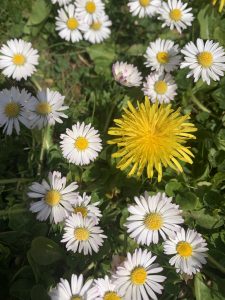
We need to look at our local species not as weeds, but as cherished wildflowers, and vital food sources for some of our rarest creatures. In Ireland, one third of our bee species is facing extinction: this is a sobering fact. They need food when they emerge from hibernation in the spring, and those shiny yellow Dandelions which many of us dread in the garden are a vital food source for them.
Other Irish wildflowers such as Daisies, red and white Clovers, Birds-foot Trefoil and Vetch may not match the skewed vision of flamboyantly-coloured wildflowers presented on packets, but these are Irish wildflowers, the species our bees survive and thrive on. In a way, accepting them is like accepting ourselves as we truly are – lets accept our weeds for what they truly are: stunning Irish wildflowers.
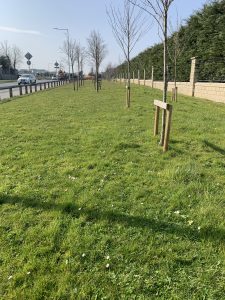
Urban mini meadows
Urban “mini meadows” can be achieved easily through reduced mowing, and are more sustainable than sowing exotic wildflower mixes. They will get better and better and last year after year, and are totally suited to the Irish climate. All we need to do to develop these areas into flower rich wildflower meadows is reduce mowing, along with reducing fertiliser and herbicide inputs.
This will go a long way to protect biodiversity, help our bees and other pollinators survive, as well as all our other grassland plants and animals. This has been proved by recent research at Trinity College Dublin, which compared pollinator visits to planted exotic wildflower mixes and local grasslands managed for Irish wildflowers in Dublin. The research found that we really don’t need to go plastering the place with wildflower seed mixes to support bees and pollinators: simple changes to grass management through less mowing were found to support “diverse plant assemblages and plentiful resources for insect pollinators”. Campaigns like No Mow May and Don’t Mow Let it Grow really do work for pollinators.
We can still grow non-native species in our gardens to support bees and pollinators
As long as you don’t allow them to escape into the wider landscape, you can still grow non-native and exotic species in your garden to support pollinators. Having a vegetable garden full of pea family members is a great resource for bees as they are full of protein, so grow plenty of peas and beans. Early in the year is a key pinch point for bee survival when the hungry queen bees emerge after hibernation, so grow plenty of early spring flowering shrubs, bulbs and herbaceous plants.
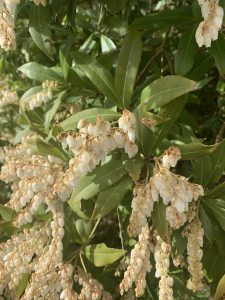
Plants such as Hellebores (Helleborus spp.), Lungwort (Pulmonaria spp), shrubs such as Pieris spp, evergreens like Skimmia japonica as well as excellent pollen-rich Willow (Salix) were all found to be an excellent food resource for bees early in the year in a recent study from Bristol (Tew et. al 2021).
Autumn is another pinch point for bee survival before their hibernation, so plants such as the humble Ivy (Hedera helix), along with attractive perennials such as Verbena bonariensis and Sedums were also found to be an excellent resource for them. Perennial plants are a good investment: they will come back year after year and require little maintenance.
The Bristol study also found an impressive 636 species of flowering plants in 59 gardens surveyed, and shrubs were found to be the main plant contributing to nectar (58%). However, a species might be very rich in nectar but inaccessible to bees, like Fuschia (Fuschia spp.), which has nectar at the end of long narrow tubes which bees cant reach. (Tew et. al 2021).
So, when you choose plants for your garden to support the bees, choose ones with open single flowers or narrow tubular flowers. Stay away from double flowers and long tubes as these are a tight squeeze for a bee or have very little nectar. By sustainably planting exotic plants in your garden rich in pollen and nectar, as opposed to flashy annual, non-native wildflower seed mixes, you will help support Irish bees, butterflies and other pollinators long into the future. The species we select and the way we manage our gardens is vital. Not every plant nor every garden is a good bee garden, so seek advice and choose wisely.
Spreading the good word…
In folklore, bees are important news keepers and send messages to the gods. Bees are also easily offended, so I’m sure they’re not impressed with us digging up native wildflowers and replacing them flashy exotic wildflower seed mixes, poor in nectar and pollen.
It is also said that bees should be treated like members of the family, and we most definitely wouldn’t dare interfere with our families favourite foods. Some of us remember the early days when exotic dishes like Lasagne and Spaghetti bolognaise arrived to Ireland, and many of us still need to have a potato with them to make them a “real dinner”. In the same way, our bees still need a “dollop of dandelions” to accompany the exotics as they also don’t quite fill them up in the same way.
The Food and Agriculture Organisation of the United Nations (FAO) state that bees pollinate the majority of our food crops, with 3 out of 4 food crops across the globe producing fruits or seeds for human use depending, at least in part, on pollinators.
With one third of Irish bees species under threat of extinction, we need action now. All the more reason to get out there, turn a blind eye to the Dandelions and turn our gardens, lawns and urban grasslands into bee food. Let’s move away from resource-poor flashy exotic wildflower seed mixes and invest our efforts in local wildflowers, trees, shrubs and herbaceous species that are resource-rich, sustainable, and can supply a bee with a “real dinner”.
Dr Noeleen Smyth is an Assistant Professor in Environmental Horticulture at UCD. She is a qualified botanist and chartered horticulturalist with 30 years’ national and international experience in environment, amenity horticulture and conservation botany. Her mission is to “cultivate a wider perspective” for the role of horticulture and the skills it brings to building a better and more environmentally sound and sustainable future for all.
References and further reading:
Why we don’t recommend wildflower seed mixes » All-Ireland Pollinator Plan (pollinators.ie)
Pollinator-friendly grass cutting A5 Flyer. (pollinators.ie)
Taxonomic and functional trait diversity of wild bees in different urban settings [PeerJ]
The case against ‘wildflower’ seed mixtures – Dublin Naturalists’ Field Club
